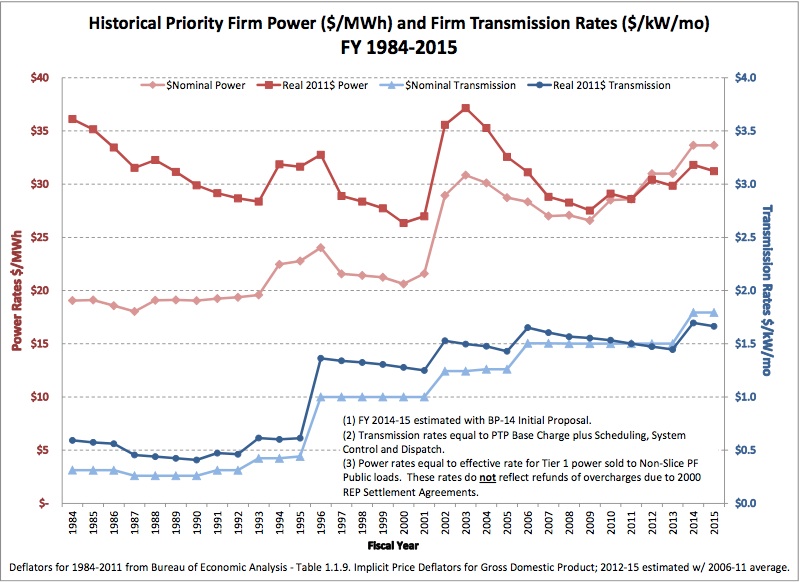forum
library
tutorial
contact

BPA Gets Spending Reductions from Fish/Wildlife
Project Sponsors in Effort to Manage Costs
by Staff
Columbia Basin Bulletin, November 9, 2012
|
the film forum library tutorial contact |

|
BPA Gets Spending Reductions from Fish/Wildlife
by Staff
|
 The Bonneville Power Administration asked for help this summer in reining in Columbia River basin fish and wildlife spending, and got it to the tune of an estimated $15 million in projected project deferrals and efficiencies for fiscal years 2012 and 2013.
The Bonneville Power Administration asked for help this summer in reining in Columbia River basin fish and wildlife spending, and got it to the tune of an estimated $15 million in projected project deferrals and efficiencies for fiscal years 2012 and 2013.
Spending during fiscal 2012, which ended Sept. 30, started fast and continued at a pace faster than anticipated. The federal power marketing agency's administrator sets spending levels based on power rate development processes that take into account projected sales and markets, and such costs as fish and wildlife mitigation for impacts caused by the Federal Columbia River Power System. BPA sells power generated in that hydro system.
BPA this summer sent letters to all of its fish and wildlife project contract holders asking them to hold the line. The June and August letters requested assistance with managing spending.
"Throughout 2012, BPA collaborated with all sponsors to reduced spending where possible with a more focused effort in September to identify project efficiencies to reduce costs and low-priority work that could be deferred in FY12/13 contracts," according to Maslen's Tuesday presentation to the Council.
The so-called "Big 6" had been asked to target from 10 to 15 percent reductions in for 2012-2013. The Big 6 includes "non-accord" entities with the largest combined monetary commitment from BPA for the period -- the states of Oregon and Washington, the Nez Perce Tribe, the Kootenai Tribes of Idaho, the Pacific States Marine Fisheries Commission and the U.S. Fish and Wildlife Service.
The accords are spending agreements signed by Bonneville and other federal agencies with numerous states and tribes that pledge funding for specific projects during the 2008-2017 period.
The spending reduction pledges received from each of the Big 6 entities "were all about 10 percent," said BPA Fish and Wildlife Program Manager Bill Maslen. By entity those cutbacks ranged from $1.5 million to $3.1 million for the two-year period, Maslen told the Northwest Power and Conservation Council Tuesday. Most of the mitigation projects funded by Bonneville are channeled through the Council's program for review.
Spending is up for a variety of reasons, the accords for one. Also drawing additional funding is NOAA Fisheries' 2008/2010 Endangered Species Act biological opinion. The BiOp calls on the federal action agencies to implement a variety of projects, and monitor their success, aimed at improving the survival of 13 wild salmon and steelhead stocks that migrate up and down the hydro system.
Spending in 2012 got off to an unexpectedly fast pace, with BiOp implementation starting to approach full bloom, and continued above expected levels. Following completion of a recent rate procedure, Bonneville added a total of $13 million to the fish and wildlife budget for a total of $492 million for the 2012-2013 period.
When the final accounting is done BPA expects that 2012 spending will amount to about $249 million, which leaves about $243 million for 2013 under the current BPA spending authority.
In all, spending projections for 2013 total $270 million, including $99 million for BiOp projects, $108 million for accord projects, $45 million general (non-accord/non-BiOp projects) and $17.7 million for BPA fish and wildlife program overhead.
"We'll have to be watching that every step of the way," Maslen said of the need hold spending to $249 million. In years past any year's spending totals have generally lagged behind start-of-year projections in large part because of delays in project implementation. Fiscal Year 2012 was an exception.
The 2013 fiscal year did get off to a more modest start with $15.7 million in October spending as compared to $17.5 million the previous year.
"We're on a path to manage this," Maslen said of the spending trajectory.
BPA in 2012 also spent about $47 million of the $50 million it had budgeted for capital projects (construction and habitat acquisition).
Plans are for an ever-rising fish and wildlife budget. Bonneville plans to spend $254 million in 2014 and $260 million in 2015.
BPA spending steadily rose from just over $100 million in 2000 and 2001 to about $140 million in 2008. Those budgets then spiked with the completion of the FCRPS BiOp in 2008 and the signing of accords, which began shortly thereafter.
learn more on topics covered in the film
see the video
read the script
learn the songs
discussion forum
